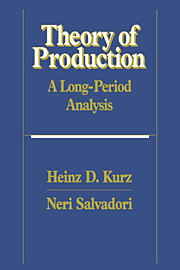Book contents
- Frontmatter
- Contents
- Preface
- A reader's guide
- 1 Free competition and long-period positions
- 2 A one-commodity model
- 3 Two-commodity models
- 4 Models with any number of commodities
- 5 Choice of technique
- 6 Alternative descriptions of a technique
- 7 Fixed capital
- 8 Joint production
- 9 Jointly utilized machines
- 10 Land
- 11 Persistent wage and profit rate differentials
- 12 On limits to the long-period method
- 13 Production as a circular flow and the concept of surplus
- 14 The neoclassical theory of distribution and the problem of capital
- 15 On some alternative theories of distribution
- Mathematical appendix
- References
- Name index
- Subject index
11 - Persistent wage and profit rate differentials
Published online by Cambridge University Press: 06 January 2010
- Frontmatter
- Contents
- Preface
- A reader's guide
- 1 Free competition and long-period positions
- 2 A one-commodity model
- 3 Two-commodity models
- 4 Models with any number of commodities
- 5 Choice of technique
- 6 Alternative descriptions of a technique
- 7 Fixed capital
- 8 Joint production
- 9 Jointly utilized machines
- 10 Land
- 11 Persistent wage and profit rate differentials
- 12 On limits to the long-period method
- 13 Production as a circular flow and the concept of surplus
- 14 The neoclassical theory of distribution and the problem of capital
- 15 On some alternative theories of distribution
- Mathematical appendix
- References
- Name index
- Subject index
Summary
The long-period analysis presented up to now has been subject to a set of simplifying assumptions, two of which will be weakened in the present chapter. This concerns, first, the assumption that labor is homogeneous and, second, the hypothesis that there is a uniform rate of profit throughout the economy. This second concept was motivated in Chapter 1 in terms of a tendency toward an equalization of the rates of return in different employments of capital in conditions of free competition due to the cost-minimizing behavior of producers. In that chapter it was also pointed out that the classical economists saw factors at work that accounted for persistent inequalities in wage and profit rates. In this chapter we will follow them and take into consideration different qualities of labor and different employments of the same quality of labor as well as different employments of capital, where the differences in quality or employment generally give rise to differences in the ordinary wage rates and rates of profit of the different labors and capitals. Hence, a major concern in this chapter will be with discussing some of the main factors determining wage and profit rate differentials in a long-period position.
The classical authors and in particular Adam Smith took pains to provide theoretical reasons why such differentials do exist: Smith's analysis “Of Wages and Profit in the different Employments of Labour and Stock” in chapter X of book I of The Wealth of Nations contains a careful account of the different factors affecting the remuneration of different qualities of labor and the profitability of different employments of capital.
- Type
- Chapter
- Information
- Theory of ProductionA Long-Period Analysis, pp. 321 - 338Publisher: Cambridge University PressPrint publication year: 1995



